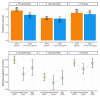COVID-19 medical papers have fewer women first authors than expected
- PMID: 32538780
- PMCID: PMC7304994
- DOI: 10.7554/eLife.58807
COVID-19 medical papers have fewer women first authors than expected
Abstract
The COVID-19 pandemic has resulted in school closures and distancing requirements that have disrupted both work and family life for many. Concerns exist that these disruptions caused by the pandemic may not have influenced men and women researchers equally. Many medical journals have published papers on the pandemic, which were generated by researchers facing the challenges of these disruptions. Here we report the results of an analysis that compared the gender distribution of authors on 1893 medical papers related to the pandemic with that on papers published in the same journals in 2019, for papers with first authors and last authors from the United States. Using mixed-effects regression models, we estimated that the proportion of COVID-19 papers with a woman first author was 19% lower than that for papers published in the same journals in 2019, while our comparisons for last authors and overall proportion of women authors per paper were inconclusive. A closer examination suggested that women's representation as first authors of COVID-19 research was particularly low for papers published in March and April 2020. Our findings are consistent with the idea that the research productivity of women, especially early-career women, has been affected more than the research productivity of men.
Keywords: COVID-19; bias; bibliometrics; gender; human; human biology; medicine; meta-research; publishing.
© 2020, Andersen et al.
Conflict of interest statement
JA, MN, NS No competing interests declared, RL Founder of TIME'S UP Healthcare, a non-profit initiative that advocates for safety and equity in healthcare; advisor for FeminEM.org, a website that supports the careers of women in medicine. RJ Has stock options as compensation for her advisory board role in Equity Quotient, a company that evaluates culture in health care companies; has received personal fees from Amgen and Vizient and grants for unrelated work from the National Institutes of Health, the Doris Duke Foundation, the Greenwall Foundation, the Komen Foundation, and Blue Cross Blue Shield of Michigan for the Michigan Radiation Oncology Quality Consortium; has a contract to conduct an investigator-initiated study with Genentech; has served as an expert witness for Sherinian and Hasso and Dressman Benzinger LaVelle; uncompensated founding member of TIME'S UP Healthcare; member of the Board of Directors of ASCO.
Figures

Comment in
-
COVID-19 and the Slide Backward for Women in Academic Medicine.JAMA Netw Open. 2020 Sep 1;3(9):e2021061. doi: 10.1001/jamanetworkopen.2020.21061. JAMA Netw Open. 2020. PMID: 32940676 No abstract available.
References
-
- Association of American Medical Colleges Medical students selected years. 2015. [June 16, 2020];2019 https://www.aamc.org/system/files/reports/1/2015table1.pdf
-
- Crawley MJ. The R Book. John Wiley & Sons; 2012.
-
- Derrick GE, Jaeger A, Chen P-Y, Sugimoto CR, Van Leeuwen TN, Larivière V. Models of parenting and its effect on academic productivity: preliminary results from an international survey. Proceedings of the 17th International Conference on Scientometrics & Infometrics International Society for Informetrics and Scientometrics.2019.
Publication types
MeSH terms
LinkOut - more resources
Full Text Sources
Miscellaneous

